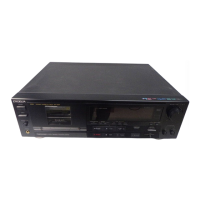
Do you have a question about the Aiwa EXCELIA XK-007H and is the answer not in the manual?
| Track System | 4-track, 2-channel stereo |
|---|---|
| Tape Speed | 4.76 cm/s |
| Total Harmonic Distortion | 0.8% |
| Type | 3-Head Cassette Deck |
| Tape Type | Type I, Type II, Type IV |
| Output | 0.41V (line) |
| Heads | 3 (1 x Record, 1 x Playback, 1 x Erase) |
Explains the meaning of graphical symbols used for safety warnings in the manual.
Warns users not to open the unit to reduce the risk of electric shock.
Warns users to not expose the appliance to rain or moisture.
Advises on placement, temperature range, and avoiding magnetic fields for optimal operation.
Discusses tape storage near magnets and the importance of head cleaning for sound quality.
Details the buttons, switches, indicators, and displays on the cassette deck.
Covers PLAY/LINE OUT, REC/LINE IN, and CD/DAT DIRECT IN jacks for audio input/output.
Describes PHONES and REMOTE CONTROL jacks for external accessories.
Covers power connection, timer settings, and loading cassettes.
Explains the automatic tape type detection feature.
Covers standard playback, auto-stop, safety lock, and operating controls.
Instructions for removing a cassette from the deck.
Details how peak levels are indicated, reset, and compared to VU levels.
Compares conventional VU levels with peak levels for signal indication.
Tips for achieving low noise and avoiding distortion by setting optimal recording levels.
Details usage, reset, limitations, and precautions for the tape running time counter.
Adjusts tape bias to match tape characteristics for accurate recording.
Sets recording levels to achieve optimal output and signal-to-noise ratio.
Details initial steps, controls, and setting recording levels and stereo balance.
Using PLAY and RECORD buttons simultaneously for editing recorded material.
Importance of the safety tab for enabling the recording mode.
Comparing SOURCE and TAPE signals for optimal sound quality and signal-to-noise ratio.
Step-by-step guide for using the memory function for stop, replay, and rewind.
Illustrates using memory to stop at a tune and repeat playback from a specific point.
Using memory functions to loop an entire tape side for continuous playback.
Using memory functions to loop a specific segment of tape between two points.
How to create blank segments under 4 seconds for editing.
How to create blank segments over 4 seconds by holding the button.
For repeated playback of a specific tape portion by rewinding and playing.
For locating selections or skipping unwanted parts by fast-forwarding.
Guidelines for using dbx NR during playback and recording, including tape marking.
Guidelines for using Dolby B-C NR, including playback settings and tape marking.
Describes the HX Pro system for improved high-frequency response and dynamic range.
Steps for setting up timed recordings using a timer unit.
Steps for setting the unit to play at a scheduled time via a timer.
Covers preventing accidental erasure, tape reuse, erasure, and deck cleaning.
Details type, track format, power supply, and power consumption.
Covers frequency response, SNR, wow/flutter, and tape speed.
Details heads, motor, inputs, outputs, dimensions, weight, and accessories.
Notes on Dolby, HX Pro, and dbx system licensing and trademarks.
Covers radio interference compliance, mains lead wiring, and model-specific safety warnings.
